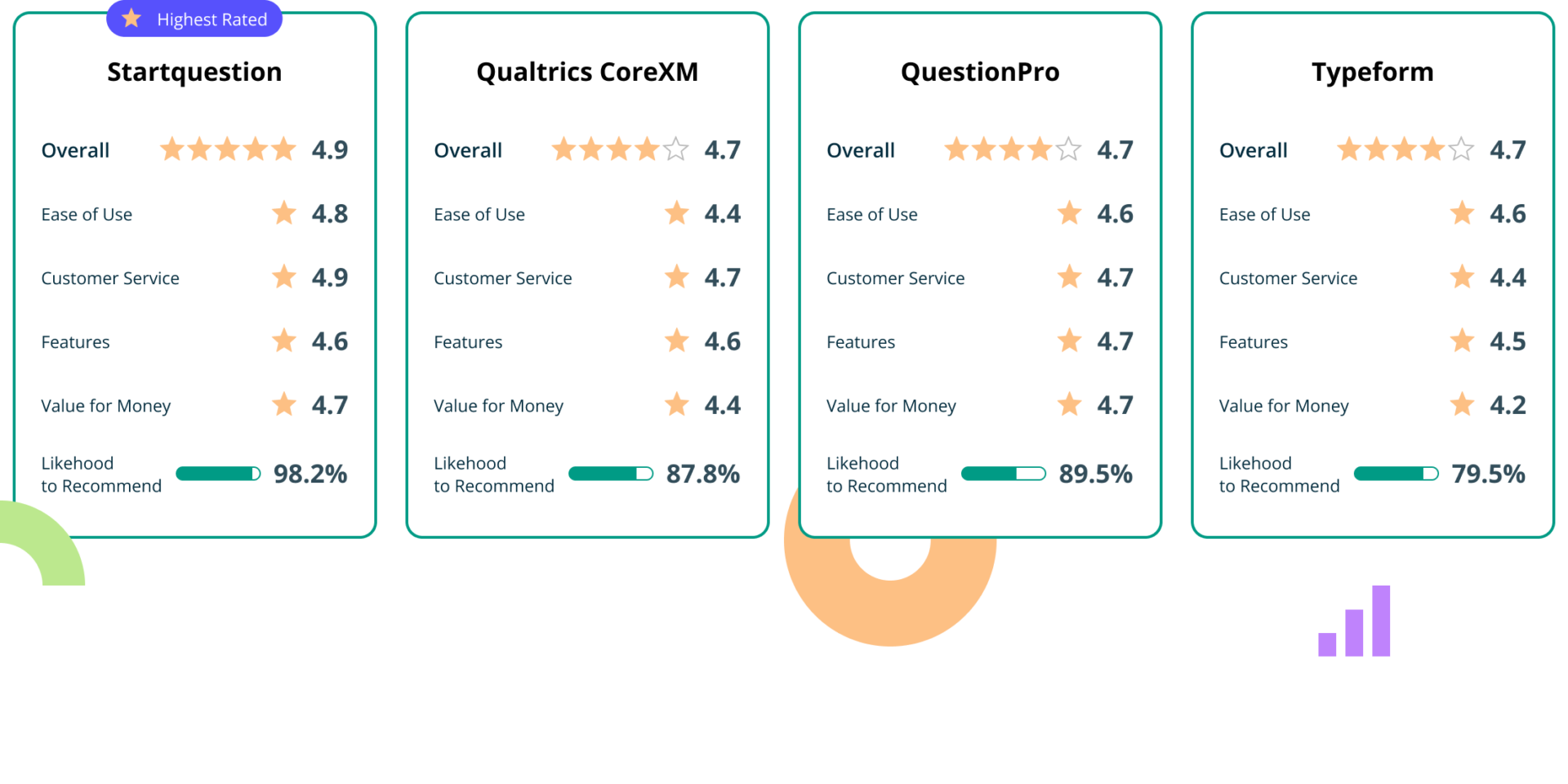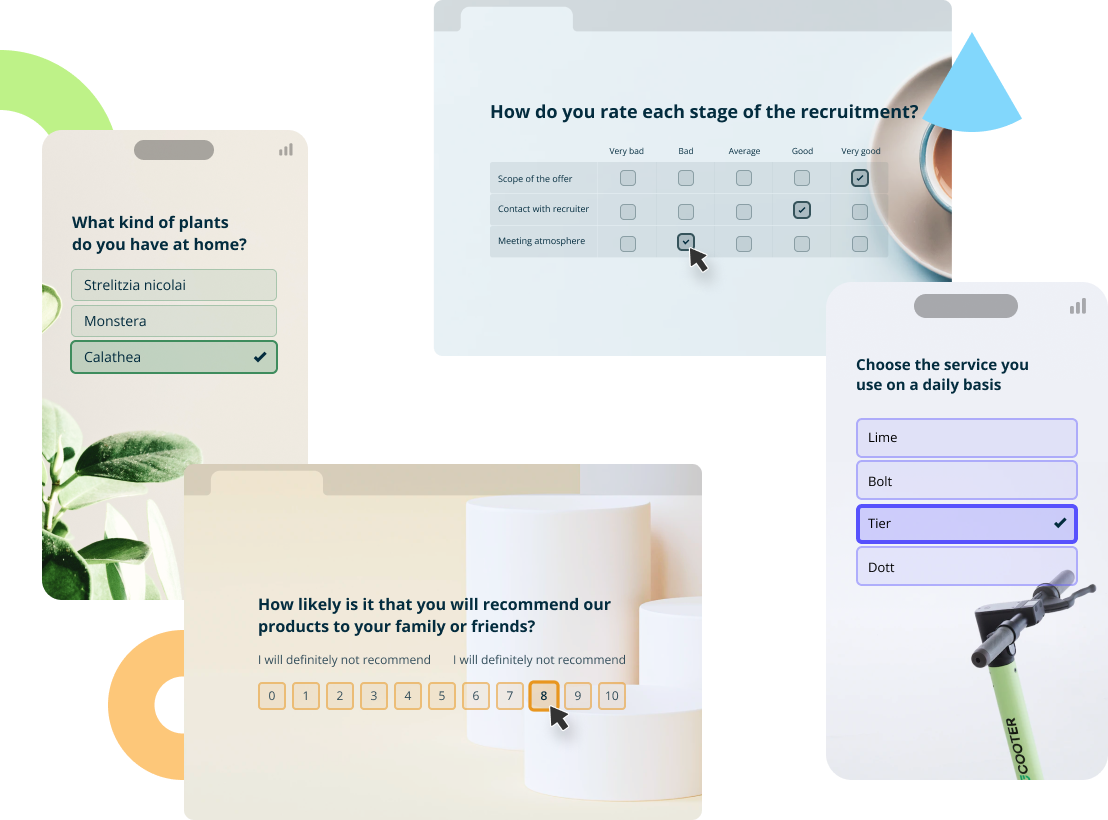Employee burnout is a prevalent issue in today’s fast-paced and demanding workplaces. It not only affects individual employees but also has a significant impact on overall productivity and the bottom line. Recognizing the signs of burnout and knowing how to address them is crucial for creating a healthy and positive work environment. Let us show you how to do it with survey software.
Understanding Employee Burnout
Before diving into the signs and solutions on how to prevent employee burnout, it’s essential to understand what the problem entails.
A worker burnout is not simply feeling tired or stressed from time to time. It’s a chronic state of physical and emotional exhaustion caused by prolonged exposure to high levels of stress and pressure.
Burnout can manifest differently in each individual, but it generally leads to reduced performance, increased absenteeism, and a negative mental and physical health impact.

How Does Workplace Burnout Affect Organizations?
Employee mental health is critical for any organization. According to a recent Zippia study, 89% of workers have experienced burnout within the past year. What does it mean to companies and the economy? Simply put, businesses also suffer when their staff experience burnout. Here’s how it affects them financially:
Employee Burnout Statistics
- Burnout is a common reason for voluntary turnover, and the cost of replacing an employee can be significant.The impact of losing a single employee can be quite substantial, often amounting to 1.5 to 2 times their annual salary (WHOOP Unite).
- As per the World Health Organization‘s data, it is estimated that a whopping 12 billion working days are forfeited annually on a global scale due to the detrimental impact of depression and anxiety. This results in a substantial cost of approximately US$ 1 trillion each year in terms of lost productivity.
- The American Psychological Association estimates that workplace stress, including burnout, costs U.S. employers more than $300 billion annually in absenteeism, turnover, and lower productivity. A study published in the Journal of Occupational and Environmental Medicine found that healthcare costs for burned-out employees are 2.5 times higher than for those not experiencing burnout.
Workplace burnout can be a costly and dangerous issue for employers. It can lead to increased absenteeism, decreased productivity, and higher turnover rates, negatively impacting workplace morale and overall company performance.
Moreover, it can increase healthcare expenses and potential legal liabilities for employers. Therefore, employers must address and prevent employee burnout in the workplace. But first, they need to recognize its symptoms.
Signs of Employee Burnout
What is the best way to recognize burnout in employees? How can you tell when an employee is burnt out? What 5 signs can you identify as burnout?
Let’s try to answer the questions that many HR professionals and business owners ask themselves every day. Five common symptoms of employee burnout include:
Reduced Productivity
Burnout often leads to a significant decline in an employee’s productivity. They may struggle to complete tasks efficiently, meet deadlines, or maintain the same level of output as before. This drop in productivity can result from mental and physical exhaustion, making it challenging for them to focus and perform at their best
Cynicism Towards People and Their Job
Employees experiencing burnout may develop a sense of cynicism or detachment from their work and colleagues. They might become more critical, negative, or apathetic toward their job responsibilities, coworkers, or the organization as a whole. This cynicism can manifest as a lack of enthusiasm, engagement, or cooperation with others.
Hopelessness
Feelings of hopelessness are common in burnout cases. Employees may perceive their situation as unchangeable and believe that their efforts won’t lead to any improvement. This sense of hopelessness can contribute to a downward spiral in motivation and well-being.
Easily Upset or Angered
Burnout can lead to increased emotional sensitivity and irritability. Employees may become more easily upset, frustrated, or angered by minor issues or challenges that they would typically handle with composure. This heightened emotional reactivity is a sign of emotional exhaustion, a key component of burnout.
Feelings of Alienation at Work
Burnout can cause employees to feel isolated and disconnected from their workplace. They may feel like they don’t belong or that their values and goals no longer align with the organization’s. This sense of alienation can lead to social withdrawal, reduced engagement, and a desire to disengage from work-related activities.

Red Flags of Employee Burnout & Job Stress
Identifying signs of workplace burnout can be challenging, but it’s crucial to remain vigilant and watch for subtle indicators that can act as warning signals. Here are some critical red flags to watch out for:
- Increased Absenteeism
If an employee starts taking more impromptu days off or calling in sick regularly without prior patterns, it could be a sign of potential burnout.
- Decreased Initiative
An individual who was once known for their proactive approach but now displays disinterest or reluctance to volunteer for projects may need help with burnout.
- Lack of Concentration
Burnout often leads to a notable decline in an employee’s ability to concentrate or make sound decisions, ultimately affecting their work quality.
- Decreased Engagement
Previously enthusiastic and engaged employees may transform into a state of disengagement and indifference towards their responsibilities and the organization’s overarching goals.
- Unhealthy Coping Mechanisms
In response to burnout, some individuals may resort to unhealthy coping mechanisms. These can include excessive consumption of caffeine or alcohol, increased smoking, or overeating as they try to manage the stress and exhaustion they’re experiencing.
To prevent mental problems in the workplace, it is necessary to listen to the voice of staff. It is essential to collect employee feedback. Survey software is one tool that can make it easier for you.
How Can Surveys Help with Recognizing Burnout?
In every workplace, it is vital to identify employee burnout, and surveys can effectively make it happen.
Detect Warning Signs with HR Surveys
Surveys allow employees to provide honest, anonymous feedback, especially on sensitive topics like burnout. They deliver measurable data that can be used to gauge workload, work-life balance, job satisfaction, and stress levels. Additionally, survey questions can directly address burnout symptoms and contributing factors.
Regular surveys track burnout trends over time, which can help evaluate interventions. Results across teams or roles can be compared to pinpoint high-risk areas. Open-ended questions can be included in surveys to provide context and employee insights.
Ask and Avoid Employee Burnout
With simple Employee Burnout Survey you can identify problems and help your team to manage with recurring problem known as employee burnout.
Ask and Avoid Employee Burnout
With simple Employee Burnout Survey you can identify problems and help your team to manage with recurring problem known as employee burnout.
Surveys can detect early signs of burnout, allowing for proactive intervention. They can be tailored to your organization’s culture and needs and used to compare your burnout rates with industry standards. Survey data can also create action plans for policy changes, training, or support systems.
It is important to note that surveys complement a broader approach that includes qualitative feedback and a supportive work environment. Therefore, it is crucial to assess and adapt your strategies to combat burnout continually.
Questions to Ask in a Burnout Survey
- On a scale of 1 to 5, how often do you feel emotionally drained or exhausted due to work-related factors?
- How satisfied are you with your current work-life balance? (Scale: Very Satisfied, Satisfied, Neutral, Dissatisfied, Very Dissatisfied)
- Do you feel that your workload is manageable, or is it overwhelming? (Scale: Manageable, Somewhat Overwhelming, Very Overwhelming)
- Have you experienced a decrease in enthusiasm or commitment to your job recently? (Yes/No)
- Do you believe there is adequate support and resources available to help you cope with job-related stress? (Yes/No)
We have prepared more ready-to-use HR survey templates and an AI-powered survey generator that can help you create any questionnaire you need quickly and easily.
Try AI Survey Creator and Start Your Research in Minutes
How to Avoid Employee Burnout?
To effectively address and overcome employee burnout, it’s crucial to prioritize employee well-being and proactively take steps to prevent and mitigate its effects. Here’s how to design your employees’ experience to reduce burnout:
Prioritize Employee Well-Being
Make employee well-being a central focus of your organization’s culture and policies. Create an environment where employees feel supported and valued, both professionally and personally.
Provide Recovery Time
Encourage and enable employees to take breaks, vacations, and mental health days as needed. Recognize the importance of downtime for rejuvenation and stress reduction.
Build Connections Between Employees
Foster a sense of belonging and camaraderie among your workforce. Encourage teamwork, social interactions, and opportunities for employees to connect with one another, reducing feelings of isolation.
Provide Clear Feedback
Regularly communicate with employees about their performance and growth opportunities. Clear and constructive feedback can help employees understand their role and expectations, reducing uncertainty and anxiety.
Be Transparent
Maintain transparency in organizational decisions and changes. When employees understand the reasons behind decisions and can see the bigger picture, it can reduce feelings of powerlessness and frustration.
To prevent employee burnout and create a more productive work environment, it’s essential to implement effective strategies. Moreover, if you notice an employee struggling with burnout, be prepared to provide support and assistance.
Open communication, flexibility, and access to mental health resources can significantly contribute to helping an employee recover from burnout and improve their overall well-being.
Addressing Employee Burnout – Checklist
Here’s what job seekers and your current employees would appreciate in a friendly and caring working environment.
- Open Communication
Create an environment where employees feel comfortable discussing their feelings and stressors. Encourage open and honest conversations about burnout.
- Supportive Leadership
Leadership plays a vital role in preventing and managing burnout. Ensure managers and supervisors are trained to identify and address team burnout.
- Work-Life Balance
Promote a healthy work-life balance by encouraging employees to take breaks, use their vacation time, and avoid excessive overtime.
- Employee Assistance Programs (EAPs)
Offer EAPs that provide counseling and resources to help employees cope with stress and burnout.
- Flexible Scheduling
Consider offering flexible work arrangements such as remote work or flexible hours to help employees better manage their responsibilities.
- Promote Mental Health Days
Employee mental health days are paid leaves that permit employees to take time off for their mental well-being, helping them manage stress and maintain their overall performance and happiness at work.
Gallup Employee Engagement Survey
A happy employee is your best investment – if you are working in HR you know this sentence for sure. The main goal of employee engagement survey is to cover the largest possible area of everyday life of employees in the company.
Gallup Employee Engagement Survey
A happy employee is your best investment – if you are working in HR you know this sentence for sure. The main goal of employee engagement survey is to cover the largest possible area of everyday life of employees in the company.
Why Employee Engagement Is So Important
Ignoring the unmistakable signs of burnout can result in a multitude of adverse consequences, including diminished productivity, elevated turnover rates, and detrimental effects on employee well-being.
However, when organizations acknowledge these signs and proactively take measures to combat burnout, they not only mitigate these negative outcomes but also foster a more vibrant and efficient work environment.
In addressing employee burnout, it is crucial to emphasize the importance of supporting your workforce. When employees feel supported, they are more likely to remain engaged and committed to their roles.
Encourage Employees to Thrive
Engaged employees tend to be more resilient and better equipped to handle the demands of their jobs. Therefore, fostering a workplace culture that promotes engagement is paramount. This involves providing opportunities for skill development, offering clear career advancement paths, and recognizing and rewarding employees for their contributions.
It is also crucial to remember that addressing burnout is an ongoing process, rather than a one-time fix. Regularly assess your workplace culture and policies to ensure they not only support but actively promote employee well-being.
By consistently monitoring and improving these aspects, organizations can create an environment where burnout is less likely to occur.
Ready to regularly check employee stress and burnout signs?




